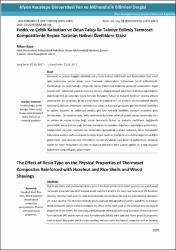Fındık ve çeltik kabukları ve odun talaşı ile takviye edilmiş termoset kompozitlerde reçine türünün fiziksel özelliklere etkisi
Özet
Ekonomik ve çevresel kaygılar sebebiyle son yıllarda mobilya sektörünün ana hammaddesi olan masif
ağaç malzemeler yerine ahşap esaslı kompozit malzemelerin kullanılması tercih edilmektedir.
Fındıkkabuğu ve çeltik kabuğu, ülkemizde henüz endüstriyel kullanıma girmemiş yenilenebilir doğal
kaynaklardır. Çalışmanın amacı bu tarımsal atıkların ahşap kompozit panellerin üretimine uygunluğunu
değerlendirmek ve kullanılan reçine türünün levhaların fiziksel ve mekanik özellikleri üzerine etkisini
incelemektir. Bu çalışmada, iki tip reçine (fenol formaldehit (FF) ve melamin-üre formaldehit (MÜF))
kullanılarak levhalar üretilmiştir. Levhaların su tutma ve hacimsel genişleme gibi bazı fiziksel özellikleri
ile eğilme dayanımı ve elastikiyet modülü gibi bazı mekanik özellikleri standart metotlara göre
belirlenmiştir. Deneysel sonuçlar, levha üretiminde kullanılan selülozik yapıda odunsu hammadde türü
ve miktarı ile reçine türüne bağlı olarak levhalarda fiziksel ve mekanik özelliklerin değişkenlik
gösterdiğini ancak üretilen çoğu levhada standartlarda istenilen değerlerin sağlandığını göstermiştir.
Gözlemlenen sonuçlar, melamin-üre formaldehit kullanılarak üretilen levhaların fenol formaldehit
kullanılarak üretilen levhalara kıyasla nispeten düşük hacimsel genişleme ve su tutma değerleri verdiğini
göstermiştir. Yani melamin-üre formaldehit reçinesi levhalarda suya dayanımı geliştirmiştir. Mekanik
testler ise fenol formaldehit reçinesi ile üretilen levhaların daha yüksek eğilme ve iç bağ dayanım
değerlerine sahip olduğunu göstermiştir. Due to economic and environmental concerns, it has been preferred in recent years to use wood based
composite materials instead of massive wood materials, which is the main raw material of the furniture
industry. Hazelnut shell and rice shell are renewable natural resources that has not industrial utilization
yet in our country. The objective of study was to evaluate this agricultural waste's suitability to produce
wood composite panels and to investigate the effect of the resin used on the physical and mechanical
properties of the panels. For this study, particleboards were produced using two types of resins (phenol
formaldehyde (PF) and melamine-urea formaldehyde (MUF)) were selected. Some physical properties
such as water absorption and thickness swelling and also some mechanical properties such as bending strength and modulus of elasticity of the particleboards were determined according to standard
methods. Experimental results showed that physical and mechanical properties of the particleboards
were variable depending on the amount and type of woody raw material in the cellulosic structure and
also type of resine used in particleboards production. But most particleboards produced in this study
showed the desired values in the standards. The observed results indicated that particleboards
produced utilizing melamine-urea formaldehyde gave relatively low thickness swelling and water
absorption values compared to the boards made from phenol formaldehyde. That is, the melamineurea
formaldehyde resin has improved the water resistance in the particleboards. Mechanical tests
indicated that particleboards which were produced with phenol formaldehyde resine resulted in higher
bending and internal bond strength values.
Kaynak
Afyon Kocatepe Üniversitesi, Fen ve Mühendislik Bilimleri DergisiCilt
17Sayı
3Bağlantı
http://fenbildergi.aku.edu.tr/wp-content/uploads/2017/12/035701-1076-1087.pdfhttp://hdl.handle.net/11630/4841
Koleksiyonlar
- Cilt 17 : Sayı 3 [36]



















